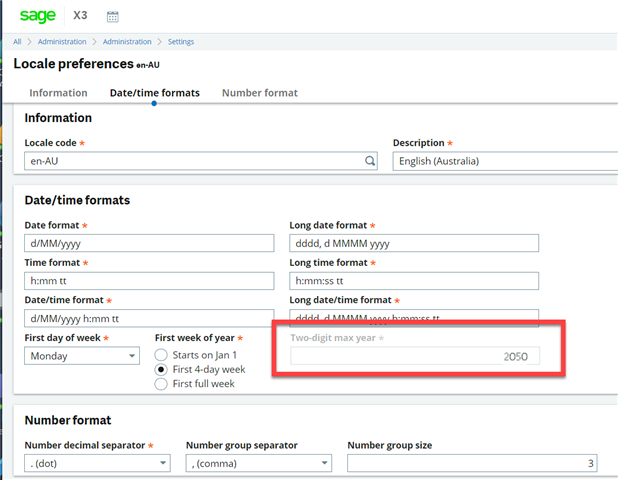 How to Change the Way Two-Digit Years are Interpreted in Sage X3
How to Change the Way Two-Digit Years are Interpreted in Sage X3

When you enter a date with a two-digit year in Sage X3 , the system determines the century based off of a “pivot year”. The default pivot year is 2029. This means that Sage X3 will interpret the year as follows:
- 00-29: Two-digit years from 00 through 29 are interpreted as 2000 through 2029
- 30-99: Two-digit years from 30 through 99 are interpreted as 1930 through 1999
The good news is that you can easily change the way two-digit years are interpreted by changing the Two-digit max year in Locale preferences.
The two-digit max year is also known as the rollover date and, as you can imagine, was very popular topic around the changing of the millennium.
UPPER AND LOWER BOUND
You need to provide a pivot date to define the century used by default when the date is two digits. Only the upper bound is entered, the lower bound is calculated accordingly.
EXAMPLE: If you enter 2050 for the upper bound:
- Any date with a year that has two digits less than or equal to 50 is in the [2000-2050] range
- Any date with a year that has two digits greater than between 51 and 99 is in the [1951-1999] range

As long as you have no data in the system with two-digit years prior to 1950 it will then start “pivoting” on 2050. Birthdays can be a problem because folks born in 1949 with a two-digit year entered would be displayed as 2049 but you can avoid this issue by using a 4-digit year anywhere that exists.
For more information about changing the way two-digit years are interpreted in Sage X3, or for any other Sage X3 questions, please contact us.
NOTE: Portions of the content for this blog post were originally posted on Sage City, September 16, 2022



